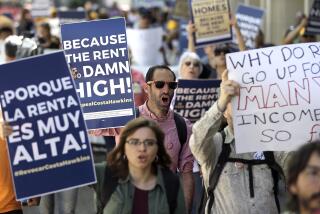Board Won’t Enforce Limit on Occupants
- Share via
QUESTION: I own a condominium that is rented out. My tenant is bothered by the very noisy occupants in the adjoining unit. Our association rules say that only four people may reside in the units, however there are at least six or seven people there all the time.
I have asked the board and the management company to enforce the rules limiting the number of occupants, but they say that the rule cannot be enforced.
I feel that I was misled when I purchased my unit if the CC&Rs; and rules are not enforceable. I am ready to sell out and sue the board of directors for any loss. What else can I do?
ANSWER: Many association boards and management companies are afraid to try to enforce limits on occupancy since the Federal Fair Housing Amendments Act went into effect. However, some restrictions are enforceable.
First, check if a governmental authority might provide assistance. Call the building and safety department of your city administration office or county health administration department to inquire about their codes and ordinances. Check if there are occupancy limits based upon the number of people per square foot of floor space or per bathroom. You may be able to get some of the occupants evicted with the city’s help.
By referring you to the city or county, I do not mean to imply that the board has the right to ignore its obligation to enforce the governing documents. Unless the association’s legal counsel has advised them that the rule is unenforceable, they have an obligation to enforce the rule. You may find that you need the support of other owners to persuade the board to enforce rules.
If the vast majority of the owners are disobeying a rule or if the membership decides that a rule is no longer necessary, then it should be deleted. The board should appoint an ad hoc rules committee to evaluate the association’s rules at least every three years. The rules are easier to change than the CC&Rs; or bylaws.
I urge you to pursue other alternatives before filing a lawsuit. Taking legal action should always be a last resort.
How to Convert to Staggered Board Terms
Q: Our homeowner association board has decided that it would be beneficial if directors terms expire at different times in order to provide continuity. We currently have a five-member board.
One person has suggested that we elect three board members each year and that terms be two years. Each year, only three people would be leaving the board instead of having the possibility of a complete turnover in board members.
Should we change our bylaws so that we can have six board members who serve two-year staggered terms? How should we make the change?
A: I am not an attorney, so I always recommend that the association consult legal counsel before changing legal documents.
It is better to have an uneven number on the board. Robert’s Rules of Order is generally used for guidance in board operations. Robert’s Rules dictate that the president only votes in case of a tie.
Most governing documents specify an uneven number of board members so that there will always be a majority deciding every action of the board.
Talk to your attorney about amending the bylaws to provide for two-year staggered terms. Then at the next annual meeting, the three directors getting the highest number of votes will serve two years and the other two will serve one-year terms.
At each succeeding annual election the membership will be voting on only two or three directors depending upon the number of directors whose terms are expiring.


